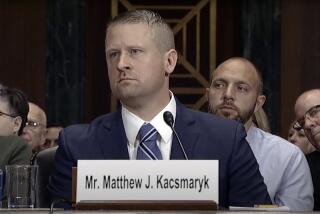Crazed Abortion Mom Kidnaps First Lady : THE AMENDMENT <i> by Sue Robinson (Birch Lane Press/ Carol Publishing Group: $17.95; 237 pp.; 0-55971-018-2) </i>
- Share via
Set in the future, “The Amendment” begins in New Orleans where abortion conservatives are celebrating their victory: the ratification of a constitutional amendment denying all women in America the option of legal and safe abortions. Until recently, this premise seemed remote, perhaps even contrived. However, the passage in Louisiana legislature of an almost identical statute gives “The Amendment” a chilling prescience.
The novel turns on a plot to kidnap First Lady Mary Morgan, leader of the Rights for the Unborn League, and to extort from her and the League the huge sum that will be required to set up an underground that will provide American women safe abortions in Sweden. Most readers will already have strong emotions and opinions on the subject of abortion. Author Sue Robinson, a former United Press International and Associated Press reporter, surely knows that their intense feelings will help carry this story and hold it together.
The book exploits a white hats/black hats, David-and-Goliath mentality. The narrow-minded injustice and hypocrisy of the league engages the reader’s own sense of vulnerability. A Southern-backwater sort of evil fills the reader with suspense: How will the league, now at the height of its power, be stopped?
We know--and hope we are wrong--that young, innocent Hilary Foster, and the courageous physician who has risked his career to help her, will die at the hands of one of the league’s back-street patrols that search out and destroy illegal abortion clinics.
Thus set up, I accepted the proposition that Hilary’s unconventional but heretofore law-abiding mother will kidnap the First Lady. I wanted to know whether Mrs. Foster would elude the cynical Jack Riley, the league’s mercenary bloodhound, who sniffs out her scheme.
It was easy to side with Robinson’s good guys, who also include a warm-hearted nurse in love with the murdered doctor/musician who, we are reminded, will play the dulcimer no more; the bright, capable Elizabeth McKinley, who suddenly finds meaning in life in avenging her best friend’s death; a respectable girls’-school dean who risks her own position (Jean Harris with a good cause?) to help young ladies in need of abortions. Never mind that these characters are white, affluent, educated and very well-connected, or that their possible success will most likely benefit their sisters who are similarly situated.
The bad-guy league members are the kinds of sanctimonious uglies we love to hate. Robinson pointedly suggests at the outset that they are contemptible:
” . . . First Lady Mary Holt Morgan’s voice vibrated to a high- fever pitch, soaring on hot-fevered wings across the high golden ceiling of the Louisiana Superdome, reaching out to the multitudes gathered there, their sweat-streaked bodies jammed tightly into every high-backed bleacher seat . . . their hot, shining eyes were fastened on the podium on the ramrod-straight, triumphant figure of the First Lady of the United States . . . the sweat of this exultant capacity crowd reeked not of the sour, salted crust of fatted perspiration, it ran sweet instead, sweet and pure as only the mother’s milk of the righteous is sweet and pure . . . Saint Mary of the terrible swift sword of righteousness . . . Saint Mary, the glorious blond Madonna of the forces for life.”
Readers familiar with Margaret Atwood’s “The Handmaid’s Tale” may be reminded of Serena Joy, another evangelical figure whose zeal in saving the unborn also is equaled only by her own self-deception and barrenness.
Robinson’s overwrought and peculiarly repetitive style has a distracted--and distracting--life of its own. The volume of images (heat, lights, circles, mirrors, eyes, darkness, and especially sweat) stupefy like a night of restless dreams. Repetition of names, words, phrases and syntax, a mannerism currently practiced with success by Joan Didion, often seems to abduct the author herself, leaving the reader in a confusion of pointless echoes and mixed metaphors: “. . . It was Jonathan’s eyes that startled Elizabeth. They were an extremely light blue, an almost transparent blue, as if lights were on behind them, and set in Jonathan’s slender, aquiline face, and punctuated by his light eyelashes and eyebrows and his light-blond hair, his light eyes seemed to glitter across a long distance at Elizabeth, glittering transparently like clear water in bright sun. . . .”
Readers in search of an examination of the issue of abortion or the subtleties of sex and politics will not linger over “The Amendment”--obviously. In fact, this novel is so generic that any of a number of other issues--gun control, for instance--could provoke equal emotional intensity for readers and provide a backdrop for this plot.
Robinson relieves the reader of any responsibility for logic or consideration of diverse views and claims--not to mention the broader contemplation of the meaning of life or the taking of it. The shape of our thinking on the matter of abortion and other gender issues and its implications is far better exposed in “The Handmaid’s Tale.”
“The Amendment” entertains in the mechanical way a bizarre amusement park attraction entertains: a ride in the gloom accompanied by lots of special effects and action, but, in the daylight an experience that would be easy to forget were it not for its particular relevance to our darkest fears.
It’s summertime. For a quick thrill, take “The Amendment” on the airplane or to the beach and pass it on to a friend. With that idea in mind, more practical abortion liberals may want to wait for the paperback edition, and, meanwhile, write to their legislators.
More to Read
Sign up for our Book Club newsletter
Get the latest news, events and more from the Los Angeles Times Book Club, and help us get L.A. reading and talking.
You may occasionally receive promotional content from the Los Angeles Times.









